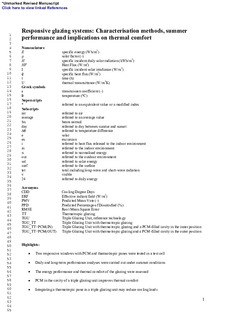Responsive glazing systems: Characterisation methods, summer performance and implications on thermal comfort
Journal article, Peer reviewed
Submitted version
Date
2017Metadata
Show full item recordCollections
Abstract
In recent years, there have been several experimental and numerical researches on transparent envelope components that integrate phase change materials (PCMs). To address some of the drawbacks of these systems, new prototypes were created and their summer performance was monitored under Cfa climatic conditions (Turin, Italy). The proposed glazing system comprises a triple glazing unit with a thermotropic layer placed on the outer side, acting as a switchable shading system capable of regulating the phase transition of the PCM. The PCM is tested in both the inner and the outer cavity of the glazing, alternately. In this paper, the summer performance of these responsive glazing systems is reported, complementing the assessment of their performance under winter conditions, which was previously presented in another paper (Bianco et al., 2017). Two additional systems were also tested in parallel for reference purposes: a triple glazing unit with a thermotropic layer only, and a reference triple glazing unit. Direct solar transmission was assessed, and the correlation between glazing temperature and solar transmission coefficient of the thermotropic layer, when coupled with the triple glazing unit, was derived. The solar transmission as a function of the external surface temperature of the PCM glazing units was also evaluated. The energy performance was assessed by means of a long-term evaluation in addition to daily analyses during cloudy and sunny days. The capability of the aforementioned technologies to improve indoor thermal comfort was investigated, with the effect of the transmitted solar radiation impinging on the occupants also taken into account. The results highlight that the integration of a thermotropic layer in a triple glazing unit allows the cooling load through the transparent component to be reduced by one third when compared to a traditional triple glazing unit. The overall energy performance was found to be primarily affected by the position of the PCM; not only during winter season, but especially in summer, the PCM completed the phase transition only when placed in the outermost cavity. The thermal comfort conditions were improved, when evaluated in terms of traditional PMV, regardless of the position of the PCM layer. However, when the influence of the direct solar radiation impinging on the occupants was taken into account, the solution with the PCM layer located in the inner cavity presented a better performance.
